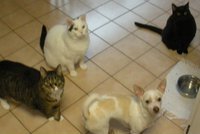Organic Pet Food: The Essentials
Posted by Purrfectplay on Oct 10, 2014

So Many Choices, written by Dr. Heidi Junger, a zoologist and life-long animal lover. Her company Onesta, makes wonderful high quality pet treats
Anyone who considers his or her pet a part of the family knows how hard it is to pick out a good pet food from the bountifully overstocked displays at the favorite neighborhood or online pet supply store. At first glance, it seems like one has seemingly limitless great choices-that is, until you actually read the fine print and begin to understand label terminology-and then wonder which claims you can trust.
Safer & Healthier For Your Pet
Organic pet foods are safer and healthier because absolutely no toxic chemicals or irradiation may be used in their manufacture or the production of individual ingredients. Among these noxious chemicals are synthetic pesticides, herbicides, sewage sludge, and corrosive sanitizers. In the case of USDA certified organic pet foods, National Organic Program (NOP) standards also prohibit the use of artificial hormones, antibiotics, genetically engineered ingredients (GMOs), most synthetic ingredients, or ingredients that aren't fully traceable to their origins. This automatically excludes those undesirable pet food ingredients which often come from multiple unknown sources, such as so-called meals, vegetable oil, animal fats, rendered fats, by-products, etc.
Beyond the fact that NOP prohibits the use of obviously toxic and unhealthy ingredients in pet foods, it becomes increasingly clear that organic ingredients contain significantly more nutrients than their conventional counterparts.
Unquestionably, organic pet foods are healthier for your pet than conventional varieties, both because no toxins are allowed in their production and because organic ingredients are richer in critical nutrients.
How To Recognize Organic Pet Foods
Only certified organic pet food claims are regulated and enforced by the US government. All other (non-certified) organic claims are not verified by an unbiased third-party (i.e., a USDA-accredited certifying agency). As a consequence, unsubstantiated organic claims can be used freely by any pet food manufacturer, even if such declarations are deceptive or outright false.
Organic certification agencies validate claims made by organic manufacturers that pet foods are 1) 100% organic; 2) USDA certified organic (in this case, more than 95% of ingredients must be organic; the remainder are ingredients which are not available in certified organic form, such as calcium carbonate); or 3) made with[at least 70%] organic ingredients. The labels of all these pet food products must disclose the name of the certifying agency. However, the use of the USDA organic seal and the 'certified organic' claim are restricted to products that contain at least 95% organic ingredients.
Another great thing about organic certification is that manufacturers have to disclose all information on their ingredients and the manufacturing processes they use. So, claims that would otherwise be hard to prove must be verified by the certifier (e.g., human grade, fair trade, etc).
Which Ones Are Best?
Not all certified organic pet foods are truly healthy.
Even some USDA certified organic pet foods contain ingredients that are known to cause health problems. One such class of unhealthy ingredients includes so-called 'refined' ingredients, such as white flours or refined oils. In other instances, manufacturers might include potential allergens in their certified organic pet foods (e.g., grains in dog food products). Also, many pet foods contain feed-grade' ingredients, which are of inferior quality compared to human grade ingredients, even if they are USDA certified organic. Organic standards for animal feeds are lower than those for food products meant for human consumption. Currently, pet foods don't have their own specific organic standards, but rather follow those established for human foods. Organic standards specifically for pet foods are in the planning phase, and will fall somewhere between feed-grade and human-grade standards.
Aside from ingredient selection, the manufacturing processes used will determine how healthful or nutritious a given pet food really is. Many pet foods are processed with high heat by cooking, canning, baking, or extruding (i.e., kibble making). This destroys many nutrients and significantly devitalizes pet foods. Freezing or low temperature dehydration processes are far superior to high temperature processes in preserving nutrient levels and quality.
Conclusion
By far the best pet foods for your animal companion are those that are USDA certified organic, human grade, whole food-based (i.e., not refined), free of problematic ingredients, and processed at low temperatures that yield a live food product. While these products are often more expensive than all those good deals you might see in stores or ads, their overall high quality will most likely save you money in the long run on veterinary care and the heartbreak of having to nurse a chronically sick animal. Since USDA certified organic foods are generally more nutritious, your animal will probably be satisfied with less food than if he or she were trying to extract her nutrients and calories from a low quality, devitalized 'bargain' food. As consumers and pet guardians, we have the right to know what we get for our money. As long as marketing regulations allow deceptive advertising and misleading labeling, we need to inform ourselves by carefully reading product labels, ever vigilant that a given manufacturer's statements may or may not reflect reality.
Resources:
Higher nutrient levels in organic foods.
www.organic-center.org/science.nutri.php
About organic certification from the USDA
www.ams.usda.gov/AMSv1.0

